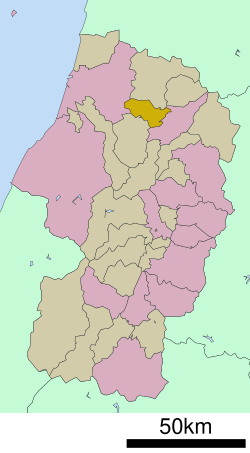world.wikisort.org - Japan
Sakegawa (鮭川村, Sakegawa-mura) is a village located in Yamagata Prefecture, Japan. As of 29 February 2020[update], the village had an estimated population of 4132 in 1347 households,[1] and a population density of 34 persons per km². The total area of the village is 122.15 square kilometres (47 sq mi).
Sakegawa
鮭川村 | |
|---|---|
Village | |
 Sakegawa Village Hall | |
 Flag  Seal | |
 Location of Sakegawa in Yamagata Prefecture | |
 Sakegawa | |
| Coordinates: 38°47′47.2″N 140°13′18.6″E | |
| Country | Japan |
| Region | Tōhoku |
| Prefecture | Yamagata |
| District | Mogami |
| Area | |
| • Total | 122.14 km2 (47.16 sq mi) |
| Population (February 2020) | |
| • Total | 4,132 |
| • Density | 34/km2 (88/sq mi) |
| Time zone | UTC+9 (Japan Standard Time) |
| - Tree | Maple |
| - Flower | Lily |
| Phone number | 0233-55-2111 |
| Address | 2003-7 Sado, Sakegawa-mura, Mogami-gun, Yamagata-ken 999-5202 |
| Website | Official website |

Geography
Sakegawa is located in northern Yamagata Prefecture, bordered to the west by the Dewa Mountains. The area is known for its heavy snowfalls in winter.
Neighboring municipalities
- Yamagata Prefecture
Climate
Sakegawa has a Humid continental climate (Köppen climate classification Cfa) with large seasonal temperature differences, with warm to hot (and often humid) summers and cold (sometimes severely cold) winters. Precipitation is significant throughout the year, but is heaviest from August to October. The average annual temperature in Sakegawa is 10.6 °C. The average annual rainfall is 1902 mm with September as the wettest month. The temperatures are highest on average in August, at around 24.2 °C, and lowest in January, at around -1.7 °C.[2]
Demographics
Per Japanese census data,[3] the population of Sakegawa has declined by more than half from its peak around 1950.
| Year | Pop. | ±% |
|---|---|---|
| 1920 | 6,678 | — |
| 1930 | 7,571 | +13.4% |
| 1940 | 7,608 | +0.5% |
| 1950 | 9,056 | +19.0% |
| 1960 | 8,374 | −7.5% |
| 1970 | 7,057 | −15.7% |
| 1980 | 6,645 | −5.8% |
| 1990 | 6,396 | −3.7% |
| 2000 | 5,829 | −8.9% |
| 2010 | 4,862 | −16.6% |
| 2020 | 3,902 | −19.7% |
History
The area of present-day was Sakegawa part of ancient Dewa Province. After the start of the Meiji period, the area became part of Mogami District, Yamagata Prefecture. The village of Sakegawa was established on December 1, 1954 by the merger of the villages of Toyota and Toyosato, both from Mogami District.
Economy
The economy of Sakegawa is based on agriculture. The town is famous for nameko mushrooms, of which it produces a substantial percentage for Yamagata Prefecture.[4] The town's other main exports are rice and flowers, such as roses and gentians. Sakegawa is also well known for fishing, with the Salmon Festival (鮭祭り) being held at Eco Park every October.[5]
Education
Sakegawa has one public elementary school and one public middle school operated by the village government.
Transportation
Railway
![]() East Japan Railway Company - Ōu Main Line
East Japan Railway Company - Ōu Main Line
Highway
 National Route 458
National Route 458
Sister city relations
Local attractions
Kabuki
Public kabuki theater performances are given on the first Sunday of July every year.[7]
Salmon Festival
Held on the last Sunday of October every year. During this festival people pay a set price to attempt to catch salmon out of the river with their bare hands.
Niwazuki Kannon Lantern Festival
Held in August. Floating lanterns are sent down the river beginning at the Niwazuki Buddhist temple.
Notes
- Sakegawa Village official statistics (in Japanese)
- Sakegawa climate data
- Oguni population statistics
- Sakegawa-Mura. .ocn.ne.jp. Retrieved on 2011-09-30.
- SAKEGAWA-MURA. ocn.ne.jp
- "International Exchange". List of Affiliation Partners within Prefectures. Council of Local Authorities for International Relations (CLAIR). Archived from the original on 22 December 2015. Retrieved 21 November 2015.
- Sakegawa Kabuki. Yamagata, Japan Information – Yamagata info. En.yamagata-info.com. Retrieved on 2011-09-30.
External links
 Media related to Sakegawa, Yamagata at Wikimedia Commons
Media related to Sakegawa, Yamagata at Wikimedia Commons- Official Website (in Japanese)
На других языках
- [en] Sakegawa
[es] Sakegawa (Yamagata)
Sakegawa (鮭川村, Sakegawa-mura?) es una villa localizada en la prefectura de Yamagata, Japón. En junio de 2019 tenía una población de 3.939 habitantes y una densidad de población de 32,2 personas por km². Su área total es de 122,14 km².[ru] Сакегава
Сакегава (яп. 鮭川村 Сакэгава-мура) — село в Японии, находящееся в уезде Могами префектуры Ямагата. Площадь села составляет 122,32 км²[1], население — 4388 человек (1 августа 2014)[2], плотность населения — 35,87 чел./км².Другой контент может иметь иную лицензию. Перед использованием материалов сайта WikiSort.org внимательно изучите правила лицензирования конкретных элементов наполнения сайта.
WikiSort.org - проект по пересортировке и дополнению контента Википедии